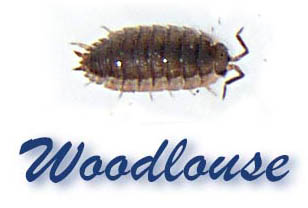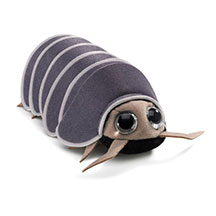
Woodlouse Facts and Information are at Animals n More.
You have noticed those little roly-poly bugs in your garden and wanted to find out more, but when you checked all your books on insects, there was nothing there. So you went to the internet and typed in roly-poly and were shocked to discover that these little bugs are not bugs at all, but crustaceans, like crabs or lobsters. Another name for these little creatures is isopod. Common names include pill bug, potato bug, roly-poly, sow bug, and wood louse.
The woodlouse has 14 parts to its body, giving it the ability to curl into a ball (congrobate) to protect itself from danger. This means that only the hard outer shell of the woodlouse is exposed. Despite the fact that the woodlouse can attempt to protect itself by curling up into a ball, it can be preyed upon by a number of animals around the world including frogs, toads, centipedes, spiders, millipedes and wasps.
The woodlouse inhabits dark, damp places in forests and jungles throughout the world. Their food consists of decaying leaf and plant matter found on the forest floor, making them natural recyclers.
The woodlouse is generally about a half inch long but in other parts of the world they can be larger. Their lifespan is about 2 years but some are known to reach the ripe old age of 4.
The woodlouse is the only species of crustacean to inhabit inland and not watery habitats. There are possibly over 3,000 different species of woodlouse around the world.
These little beasties generally have a grey or brown coloration but the exact color and size of the woodlouse is dependent on the woodlouse species and the area where the woodlouse is found. Some can be blue. You can find the woodlouse in just about every environment in the world except for polar regions and arid deserts.
Living in a terrestrial environment, woodlice breathe through trachea-like lungs in their paddle-shaped hind legs (pleopods), called pleopodal lungs.
The female woodlouse lays about 24 eggs which she keeps inside a brood pouch or marsupium. The woodlouse eggs hatch after an incubation period of just a few days. Due to the fact that the baby woodlice take a number of months to fully develop, the mother woodlouse will often stay close to her young until they mature.
Pillbugs (woodlice of the family Armadillidiidae, also known as pill woodlice) can be confused with pill millipedes of the order Glomerida. Both of these types of arthropods are about the same size. They live in very similar habitats, and they can both roll up into a ball. To the naked eye they seem to be similar.
Pill millipedes can be distinguished from woodlice on the basis of having two pairs of legs per body segment instead of one pair like all isopods. Pill millipedes have 12 to 13 body segments and about 18 pairs of legs, whereas woodlice have 11 segments and only seven pairs of legs. In addition, pill millipedes are smoother, and resemble normal millipedes in overall coloring and the shape of the segments.
The little Roly-poly plush toy finger puppet shown above is made by Folkmanis. Find them in our sponsor's website: www.jeanniescottage.com.




